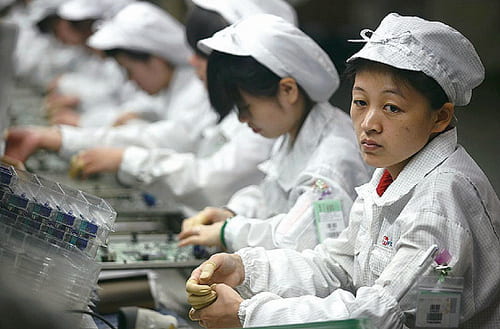Originally published on March 30, 2012
The titles of yesterday’s news stories offer an unambiguous condemnation of unfair labor practices at Apple’s Foxconn assembly plants in China:
Apple’s factories in China are breaking employment laws, audit finds;
Update: Apple supplier Foxconn hit on poor working conditions;
Illegal overtime reported on Apple assembly line;
Apple supplier audit finds major wage and overtime violations.
However, rather than joining the chorus of outrage against greedy firms who exploit workers in foreign countries and take jobs away from American workers, I want instead to suggest some of the unmentioned effects of well-intentioned fair labor regulations.
First, a bit about regulations in general. A regulation is a command issued by a government that a person or company must do something in a particular way. Failure to do so results in some penalty or punishment. By design, a regulation restricts freedom. Presumably that restriction of freedom is acceptable because it is restricting the freedom to do a bad thing.
Consider labor regulations of the sort Foxconn was found to be violating. One violation was that workers were found to have worked more than the allowable maximum of 36 hours of overtime per week. Another involved the underpayment for overtime work.
Regulations like these are needed to prevent the exploitation of workers …. (and I’m sure most people would agree that 35 hours of overtime per month is not exploitative but 37 hours surely is!)
Possibly many readers may have worked more than 36 hours of overtime at some point in their lives. Whether you were exploited depends on the circumstances. Once regulations are formulated it quickly becomes clear that the rule cannot apply to everyone. So the rules are usually written to exclude certain types of workers. This is one reason regulations often take dozens of pages to explain; because all of the exceptions must be outlined.
For example, the overtime rule is likely to apply only to wage workers but not salary workers. If you are a salary worker you might be expected to work say 60 or 80 hours a week … as you might if you are a young lawyer or doctor. This would not be considered exploitation, I suppose, because high income earners cannot be exploited in this manner. Of course, if you are a wage worker who wishes to work 60 hours per week, even for a month in an emergency circumstance, (perhaps to become a higher income earner to pay some bills) you would not be allowed to do so because of the regulation. Your freedom would be restricted … but it is for your own good.
Now lets come to the process of maintaining a regulation such as this. As soon as a labor regulation like this is in place, a firm must prepare for the potential that someone might charge a violation. So the first order of business might be to implement an overtime tracking system to document and prevent excessive overtime. That means the company needs to assign some personnel to the issue. The more regulations there are, the more documentation and procedures will be needed and the greater the number of workers to be assigned. Of course, these will be higher paying jobs because the firm will need accountants and computer programmers and legal experts to manage the regulations. We might call them regulation management.
On the other side we have the auditors, the checkers and verifiers. Once the regulations are in place we will need to hire some people to check and see that the rules are being followed. That’s what the Fair Labor Association was doing with Foxconn in China. They were hired to audit the labor practices to see if there were violations. Who hired them? Apple Computer did; … largely because stories in the press about worker exploitation in China threatened to tarnish their reputation and cost them millions. Of course to protect that reputation costs million as well. They must pay for the audit, the regulation management team, and the public relations staff involved in the incident. Tim Cook, the CEO of Apple, even traveled to a Foxconn assembly plant in China to showcase the efforts that Apple is making to do the right thing.
All of this activity takes a lot of time and costs a lot of money. The time takes highly trained individuals away from the immediate task of the company; namely to design and produce fantastic computer products. Therefore it will mean that fewer consumer products will be built.
And who pays for it all? If you said that it comes out of the high salaries of top executives at Apple Computer, you are probably wrong. Instead it is more likely to come from the slightly higher prices that will now be charged for IPhones and IPads. Even an extra 50 cents will generate tens of millions of extra dollars to pay for all of these regulatory costs. But higher prices, even a little bit, will reduce the total number of products sold and so fewer consumers will be able to enjoy the product.
In the US the process can play out a little differently and the money stakes are even larger. In the US it is typical for some law firms to seek out disgruntled workers at large corporations who have been exploited by the violation of US labor laws, perhaps the underpayment of overtime. If evidence can be gathered that the violation is a standard practice throughout the company and not an isolated incident for a few employees, then the law firm can file a class action suit against the company. I spoke with a couple of lawyers last week who work on such cases and learned that most large corporations settled these cases before going to court in order to avoid the excessive defense fees. When they settle, employees in the class action suit will get some compensation for the company’s wrongdoing … perhaps as much as a few hundred dollars each. The big winners in all of this though are the law firms who sometimes walk away with millions or billions (yes, billions!) of dollars in the settlement.
So, here’s a quick assessment of the expected effects of the labor regulations in this case. First, the exploited workers get a small share of wages returned and a feeling that justice has been done. Second, numerous regulatory management jobs are created for college-educated upper middle class workers. And finally, a small group of already wealthy lawyers, become fabulously wealthy. Who pays? That would be the consumers who buy the product. They pay a little bit more for this product and have a little bit less left over to buy other things.
On a final note, take this story about labor law and extrapolate the effects across numerous regulations, industries and issues. Think about all the examples of somebody doing something to protect themselves against regulatory lawsuits. If this assessment of the effects is accurate, then what we have, perhaps, is an ingenious system that purportedly protects the poor and defenseless members of society, (and maybe does a little bit) but which actually serves to transfer a lot of money from average consumers into the hands of a smaller group of upper middle class and wealthy people.
Oh, by the way, there is an alternative system … but rest assured that system has been denigrated sufficiently that anyone who defends it is quickly branded a naïve and insensitive cad. So I better not mention it.


